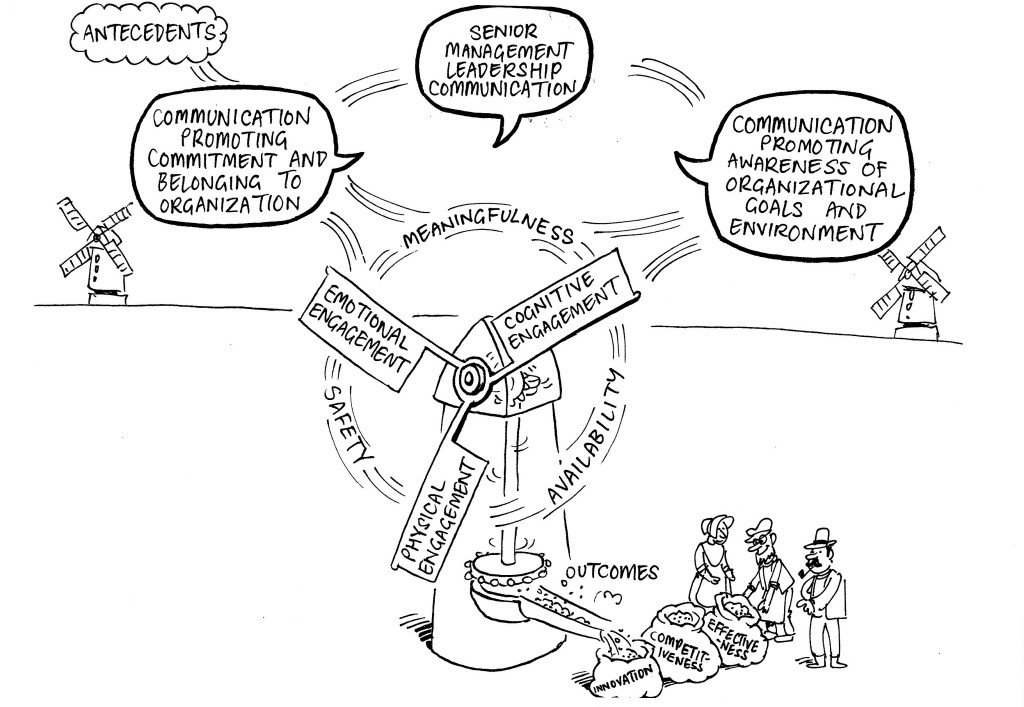Top 10 management models for your business #8: Communication and employee engagement
10 September 2014 by Catherine Holdsworth in 100+ Management Models, Business and finance
by Fons Trompenaars and Piet Hein Coebergh, co-authors of 100+ Management Models.
Problem statement
How can employee engagement be strengthened through communication?
Essence
Academic and former communications professional Mary Welch connects insights on HRM, leadership and communication in her view of employee engagement. The roots of her model can be traced back to the work of Daniel Katz and Robert Kahn, who discussed the importance of engaging with employees in their 1966 classic The Social Psychology of Organizations. This was taken up in 1999 by Gallup’s Marcus Buckingham and Curt Coffman in their book First, Break all the Rules, that claimed that engaged employees drive customer loyalty and that ‘The right people in the right roles with the right managers drive employee engagement’. Since then, business interest in the concept has prompted demand for the provision of employee engagement consultancy services, which has been met by companies including Gallup, Aon Hewitt, Mercer, Towers Watson, Hay Group, Kenexa and BlessingWhite. These companies, among many others, offer a series of reports and tools (widely available on their corporate websites) to support the bottom line by measuring and strengthening employee engagement.
How to use the model
This conceptual model illustrates the possible impact of communication on employee
engagement at an organizational level. Engagement is recognized as a three-component construct comprising emotional, cognitive and physical dimensions, associated with dedication, absorption and vigour. The three psychological conditions necessary for engagement (meaningfulness, safety and availability) that Robert Kahn identified in his later work are integrated into the model. Commitment is associated with engagement and is affected by leadership communication, so the model integrates the constructs of organizational commitment as an antecedent of engagement. It positions aspects of leadership communication from senior managers in relation to employee engagement. Communication is a psychological need of employees, which organizations have to meet to maintain and develop employee engagement. Aspects of internal corporate communication are positioned as influencing engagement variables on the one hand (by promoting commitment and a sense of belonging), and as communication engagement outcomes on the other (through awareness and understanding). The model conceptualizes innovation, competitiveness and organizational effectiveness as organizational outcomes of employee engagement, which can be promoted by effective internal corporate communication.
Results
The model encourages communicators to consider potential engagement effects of
communication strategies and tactics as well as the communication needs of employees. In combination with a wide choice of tools that are available on the Internet, typically provided by consulting firms who offer additional services for analysis and implementation, the model serves as an academic reference and possible framework for improvement plans.
Comments
Despite its importance for leaders of organizations, there is considerable academic confusion about the meaning of employee engagement and its contribution to performance. On a theoretical level, however, there appears to be consensus about the strong role of communication. This is in line with how various authors on management theory define the importance of communication in leadership, including John Kotter’s 8-step process for leading change (discussed earlier in this Part), with step four being ‘communicating the vision for buy-in’. Surprisingly, corporate communication literature has not yet adequately considered the concept of engagement. This may be due to confusion concerning the concept, and to concerns about overlaps with other constructs such as commitment. This model tackles the gap in the literature, modelling the role of internal corporate communication in enhancing employee engagement.
Literature
Albrecht, S.L. (2012) Handbook of Employee Engagement: Perspectives, Issues, Research and Practice, Cheltenham, Edward Elgar.
Groysberg, B., Slind, M. (2012) ‘Leadership is a Conversation’, Harvard Business Review, June, pp. 75–84.
Welch, M. (2011) ‘The Evolution of the Employee Engagement Concept: Communication Implications’, Corporate Communications: An International Journal, 16:4, pp. 328–346.


